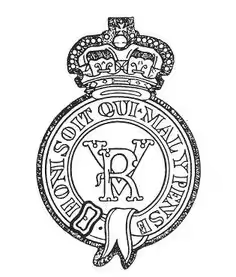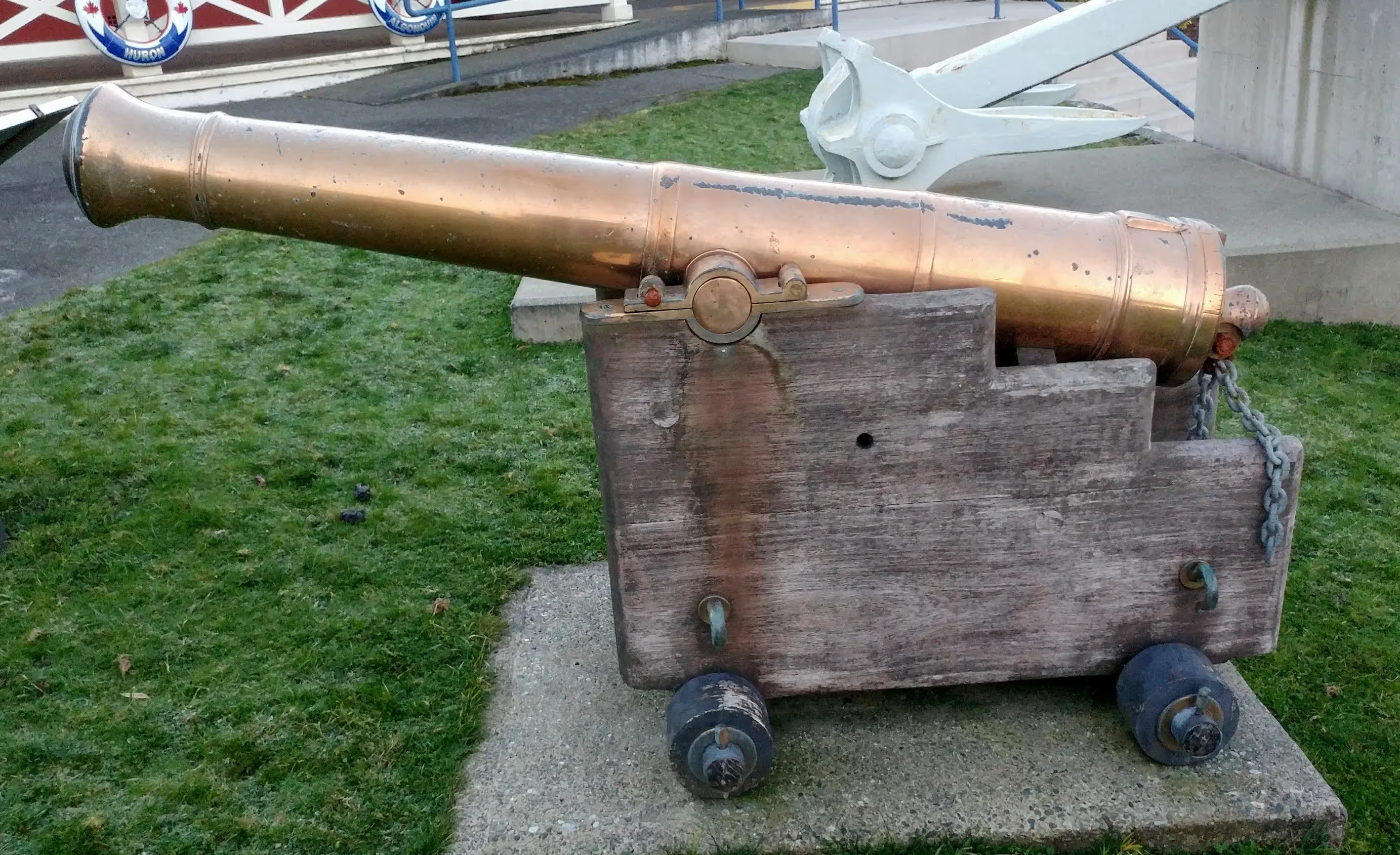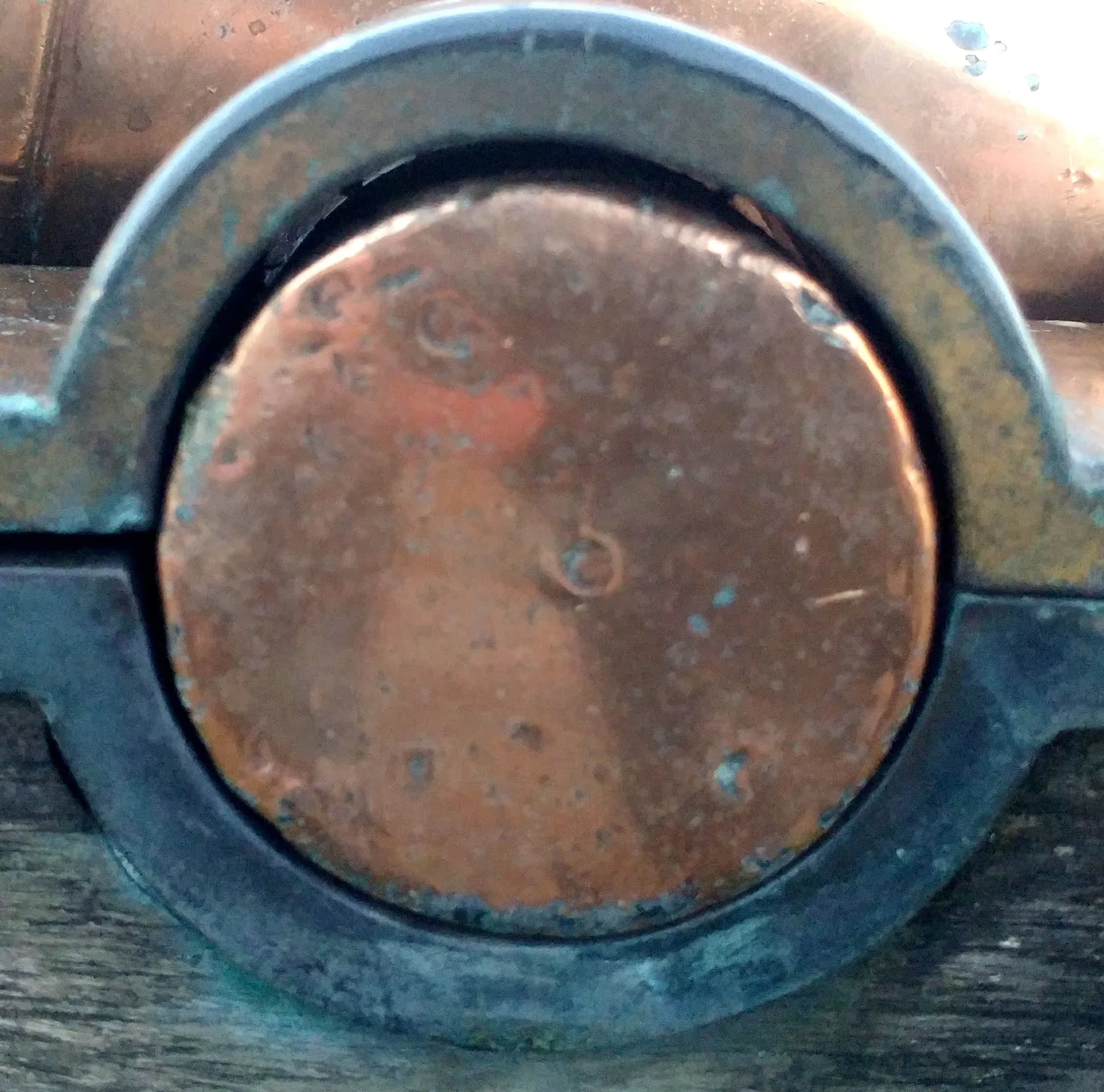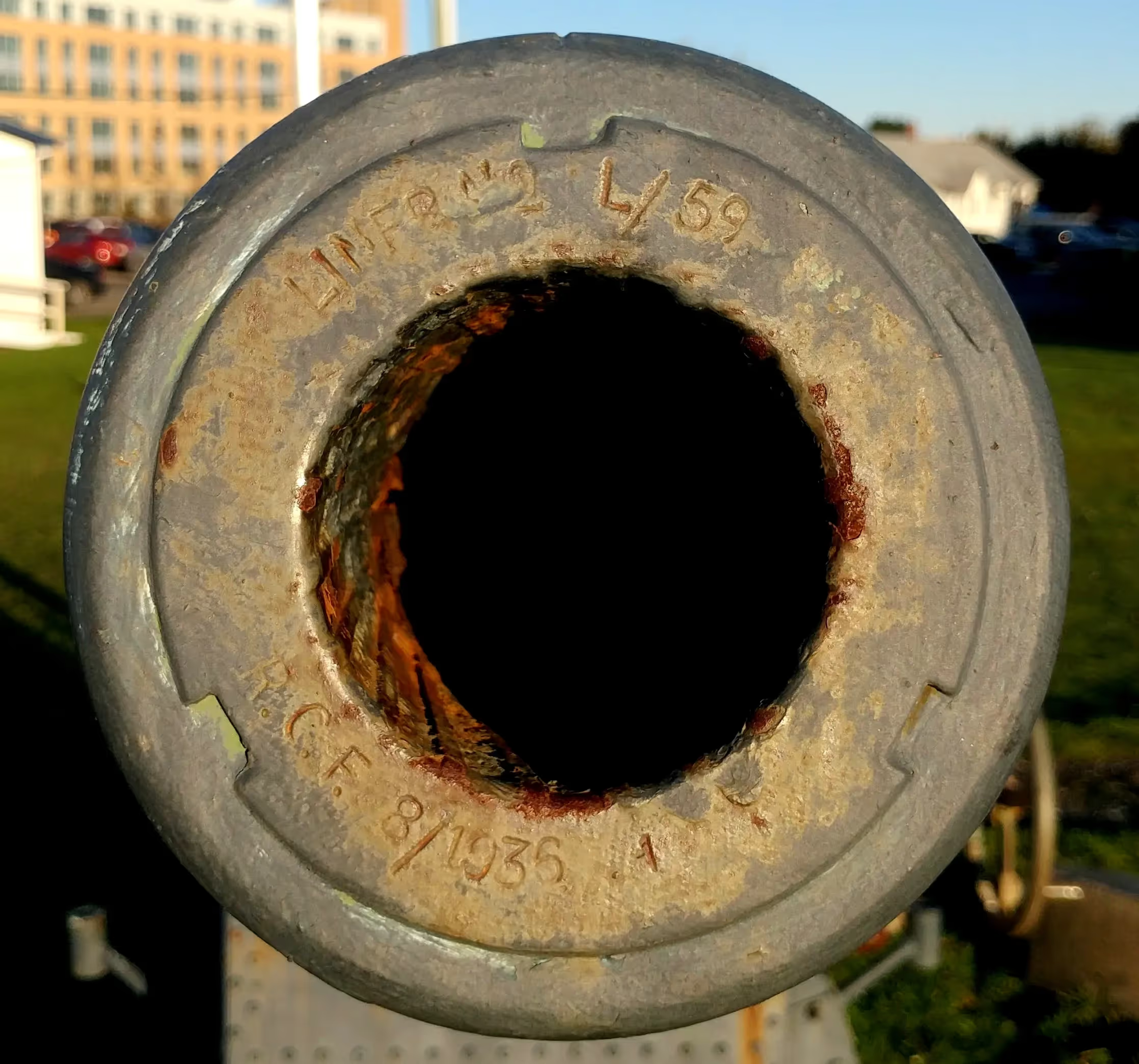Artillery in Canada (1) British Columbia: Canadian Forces Base Esquimalt, Naden and Work Point Barracks
Artillery preserved in British Columbia,
Canadian Forces Base Esquimalt, Naden and Work Point Barracks
The aim of this website is to locate, identify and document every historical piece of artillery preserved in Canada. Many contributors have assisted in the hunt for these guns to provide and update the data found on these web pages. Photos are by the author unless otherwise credited. Any errors found here are by the author, and any additions, corrections or amendments to this list of Guns and Artillery in Canada would be most welcome and may be e-mailed to the author at [email protected].
For all official data concerning the Royal Regiment of Canadian Artillery, please click on the link to their website:
Royal Regiment of Canadian Artillery Website
Note: Back in the day, artillery in Canada was referred to by its radio call sign "Sheldrake". It is now referred to by its "Golf" call sign. (Acorn sends)
British Columbia

Canadian Forces Base Esquimalt (CFB Esquimalt) is Canada's Pacific Coast naval base and home port to Maritime Forces Pacific and Joint Task Force Pacific Headquarters. It is located at the southern tip of Vancouver Island on the Strait of Juan de Fuca, adjacent to the western limit of the provincial capital, Victgoria.
CFB Esquimalt facilities include Naden (formerly HMCS Naden), and Her Majesty's Canadian (HMC) Dockyard Esquimalt, among others on site. The present dockyard and dry dock, known as HMC Dockyard Esquimalt, dates to the Royal's Esquimalt Royal Navy Dockyard (1842–1905) and was the Royal Navy's Pacific Station until 1911. Today it serves as the Canadian Naval Headquarters in the Pacific.
The CFB Esquimalt Naval & Military Museum is located at HMCS Naden. HMCS Naden was named after the Dominion Government Ship Naden, which was commissioned as a tender for the Royal Naval College of Canada from 1918 to 1922 for training in sail.

CFB Esquimalt



(Al Dadds Photos)

(Author Photo, 29 Jan 2019)
Cast Iron ½-pounder Smoothbore Muzzleloading Gun, weight 1-1-1 (129 lbs), No. 1 of 2 guarding the entrance to Building 70 in the Dockyard.
Ruth Rhynas Brown published references to these guns in an article on the guns of the East India Company: 1990 “Guns carried on East Indiamen, 1600-1800”. IJNA. vol 19, 17-22. 1995 “Arming the East Indiamen” in The Archaeology of Ships of War, ed. Mensun Bound. Oswestry. 114-119. Basically it was introduced by the Board of Ordnance.
Guns marked with the Crowned P: After Wheatley and Company were given permission to proof guns for the East India ships, the Board of Ordnance decided on 3 November 1749, that all guns "which pass the King's proof for the future, and for the Merchants' Service, be marked with a Crown and the letter P" (WO 47/34, 422v). In the next few years increasing numbers of East India Company guns were proofed and in 1755 the Company insisted that all guns for its use had to be proofed at Woolwich. Robert Davidson at Woolwich was paid for cutting crowned Ps for India ships on guns. This mark was also used for guns of a semi-official nature, such as those cast by John Fuller for the Sardinian government. It was used for the civilian branch of the government, such as for troop ships, armed transports and post office packets. The form of crowned P on guns like this one suggests an 18th century date, possibly something for a transport in the Seven Years War or American Wars. This type of gun vanishes with the introduction of the carronade.


(Al Dadds Photos)

(Author Photo, 29 Jan 2019)
Cast Iron ½-pounder Smoothbore Muzzleloading Gun, weight 1-1-1 (129 lbs), No. 2 of 2 guarding the entrance to Building 70 in the Dockyard.

(Al Dadds Photo)

(Maxwell Toms Photo)

(Maxwell Toms Photo)
3-inch 50 Mk. 33 Twin Gun Naval Turret, located beside the Canex parking lot.

(Al Dadds Photo)

(Maxwell Toms Photos)

(Maxwell Toms Photo)
3-inch 70 Mk. 6 Twin Gun Naval Turret, located beside the Canex parking lot.

(Al Dadds Photo)
ASROC Launcher Mk. 7, CFB Esquimalt.

(Al Dadds Photo)
Anti-Sub Mortar Mk. NC 10, CFB Esquimalt.

(Library and Archives Canada Photo, MIKAN No. 3723976 )
Stacks of iron cannon balls, HMCS Naden, Esquimalt, BC.





(Author Photos)
(Al Dadds Photo)


Queen Victoria cypher, on the gun barrel.

Portrait of Queen Victoria. 1859. (Wikipedia)

(Author Photos, 29 Jan 2019)
64-pounder 64-cwt Rifled Muzzleloading Gun Mk. I with Millar-pattern breeching ring, weight 64-1-0 (7,196 lbs), blank on the left trunnion, RGF No. 106, I, 1865 on the right trunnion, Queen Victoria cypher, mounted on a wood naval gun carriage. No. 1 of 2 Guns in the Dockyard, Duntze Head. This is one of the types of guns used in the 1878 coast artillery defences of Victoria - Esquimalt. They were also mounted on many classes of naval vessels from the late 1860's to the early 1880's. Nothing is known about the service history of this particular gun.
The British 64-pounder 64-cwt Rifled Muzzleloading Gun of the 1860s was a 6.3-inch (160-mm) naval, coastal defence and fortification gun which fired a projectile weighing approximately 64 pounds.

(Al Dadds Photo)


(Al Dadds Photos)







(Author Photos, 29 Feb 2019)
Blomefield Cast Iron 32-pounder 56-cwt Smoothbore Muzzleloading Gun, weight 54-2-0 (6,104 lbs), C on the left trunnion, Serial No. 29 on the right trunnion, King George III cypher, broad arrow mark, mounted on a wood Naval gun carriage. No. 2 of 2 Guns in the Dockyard, Duntze Head.
Albert Head Battery

(Library and Archives Canada Photo, MIKAN No. 3514248)
Albert Head Battery, 9.2-inch coastal defence gun, May 1940.

(Library and Archives Canada Photo, MIKAN No. 3524735)
Shells for 9.2 in. coastal defence gun, probably at Albert Head, British Columbia, 6 December 1941.

(Library and Archives Canada Photo, MIKAN No. 3524734)
Shells for 9.2 in. coastal defence gun, probably at Albert Head, British Columbia, 6 December 1941.

(Library and Archives Canada Photo, MIKAN No. 3514262)
Soldiers manning a 9.2-inch coastal defence gun on the BC coast in 1941.

(Library and Archives Canada Photo, MIKAN No. 3514263)
Soldiers manning a 9.2-inch coastal defence gun on the BC coast in 1941.
Mary Hill Battery (1939-1956)

(John Stanton Photo)
Mary Hill Battery 6-inch Mk. 24 Gun on Mk. 6 Mount, 1943.
Mary Hill Battery was a Canadian reinforced concrete 6 inch coastal gun battery that was a part of present day CFB Esquimalt, on Vancouver Island, British Columbia. This battery was part of the harbour defence of Victoria and Esquimalt Harbours. It was also considered part of the Second World War Joint United States and Canadian harbour defence of the Strait of Juan de Fuca. The Mary Hill Battery was initially armed with two 6-inch Mk. 7 breechloading (BL) guns on Mk. 5 (15 degree) mounts in 1939. An additional Mk. 7 gun was added in 1941. The battery was built to replace the three obsolete 6?inch disappearing guns at the Fort Rodd Hill Upper and Lowery batteries. These in turn were replaced in 1943 by three 6-inch Mk. 24 guns on Mk. 6 mounts (45 degree). A searchlight located on William Head was part of the defense. The battery was decommissioned in 1956.

(Library and Archives canada Photo, MIKAN No. 3514254)
Mary Hill Battery 6-inch Mk. 7 Gun on Mk. 5 Mount, firing on 6 Dec 1941.

(Library and Archives Canada Photo, MIKAN No. 3514258)
No.1 six-inch gun at Mary Hill Battery overlooking William Head Quarantine Station, 6 Dec 1941.
Black Rock Battery


(Wayne Yetman Photos)
12-pounder 12-cwt QF Mk. V (3-inch-40) Breechloading Naval Gun (Ogden 3-inch Naval gun), No. 1 of 3, originally located at Black Rock, now at the Naden dockyard.

(Al Dadds Photo)
The three 12-pounder 12-cwt QF Mk. V (3-inch-40) Breechloading Naval Guns that stood at the firing point at Black Rock have been moved to Naden in a corner of the old parade square behind the Drill Hall. Final destination unknown.

(Al Dadds Photo)
Breechblock QF 12-pounder 12-cwt, AV, N, 1, CPR 1942, Serial No. 1316/5, C/S 8.
12-pounder 12-cwt QF Mk. V (3-inch-40) Breechloading Naval Gun (Ogden 3-inch Naval gun), No. 2 of 3, originally located at Black Rock, now at the Naden dockyard.

(Al Dadds Photo)
Breechblock QF 12-pounder 12-cwt, AV, N, 1, CPR 1942, Serial No. 1405/1, C/S 164.
12-pounder 12-cwt QF Mk. V (3-inch-40) Breechloading Naval Gun (Ogden 3-inch Naval gun), No. 3 of 3, originally located at Black Rock, now at the Naden dockyard.

(Al Dadds Photo)
Breechblock QF 12-pounder 12-cwt, AV, N, 1, CPR 1942, Serial No. 1446/1, C/S 391. This gun was previously on SS Green Gables Park.






(Al Dadds Photos)
Notes on the 12-pounder 12-cwt QF Mk. V (3-inch-40) Breechloading Naval Guns (Ogden 3-inch Naval Gun), in British Columbia: The army had problems before the war with their 12-pounder being shot out and therefore a few barrels were acquired from the navy in the 1930s. The Ogden barrels seem to have the S69xx pattern. Note that in every case in the file, the gun is listed as a Mk. I. Mounting CAN 396 was an RCN mounting and was in CNAD Esquimalt in 1946. Mounting CAN 397 was also an RCN mounting and was in CNAD Esquimalt in 1946.
Barrel No. 6539 on mounting A/2514 was located at Duntze Head in 1912 along with Barrel No. 6473 on mounting A/2493 and Barrel No. 52. 6473 is later recorded at Macaulay in 1933 and then 6473 and 6539 are recorded at Black Rock on 1 Oct 1946. Barrel No. 6539 was manufactured in 1918 at the Royal Gun Factory (RGF) in the UK, so the Mk. I designation may be valid.
CFB Esquimalt Museum




(Author Photo, 29 Jan 2019)

(Al Dadds Photo)


(Author Photos, 29 Jan 2019)

(Al Dadds Photo)
Bronze 6-pounder 6-cwt Smoothbore Muzzleloading Gun, weight 5-3-25 (669 lbs), Serial No. 513 on right trunnion, No. 2 of 2, No. 1 of 2, mounted on a wood naval stand in front of the CFB Esquimalt Museum. Although the service history of these guns is unknown, they were located for many years at Royal Roads Military College (now Royal Roads University ). There, generations of Canadian officer cadets maintained these guns in such a highly polished state that gradually all of the markings were worn away.




(Author Photos, 29 Jan 2019)

(Al Dadds Photo)

(Author Photos, 29 Jan 2019)

(Al Dadds Photo)
Bronze 6-pounder 6-cwt Smoothbore Muzzleloading Gun, weight 6-0-2 (674 lbs), Serial No. 1305 on right trunnion, No. 2 of 2, mounted on a wood naval stand very worn, no details visible including ciphers. These guns are mounted in front of the CFB Esquimalt Museum.
Work Point Barracks

(Author Photo)
C Battery, 1 RCHA plaque, Work Point Barracks.

(John Eckersley Photo)

(John Eckersley Photo)







(Author Photos)
3-inch 20-cwt QF Mk. IIIA Anti-Aircraft Gun, RGF 1916, No. 1013, RGF 1918, 1 1591, with the breech stamped III & III*, RGF 1919, (Serial No. 2018), breech RGF 1918 No. 1013 stamped out, 1918 L/1591, mounted on the grounds of Work Point Barracks, just to the East of the Work Point Power Club building. The breech mechanism on the Mark III used a two-motion screw system (the breech is opened and closed in two motions), which was introduced for speed of production in 1917. The Mk. III* was the same as the Mk. III but with rifling with one turn in 40 calibres, and it came out in 1918. The gun had a maximum range of 23,500' and fired shrapnel, HE and incendiary ammunition. It remained in use throughout the Second World War.
It is possible the marking in the photo of the breech shown here which would have meant it was interchangeable with either the Mk. III or Mk. III* guns. According to Ian Hogg, the Mk. IIIA was a Mk. III or a Mk. III* which had been repaired by the removal of the “A” tube and wire and replaced by an autofrettaged loose liner about 1933. In English, the original barrel was a steel tube (“A” tube) wrapped with tightly wound wire and covered with a steel jacket. The barrel and wire could be removed using hydraulic pressure and replaced - cheaper than a complete new barrel. In this case it was replaced with a liner (think inner barrel) which had been pre-stressed using hydraulic pressure (autofrettaged) which gave a strong barrel. (Doug Knight)
This gun is in a location overlooking Victoria Harbour from whence, for many year the artillery fired the daily time gun. It was placed here as a memorial by the Royal Canadian Artillery Association. While other guns were adapted to fire at aircraft during the First World War, the 3-inch 20-cwt was the first British gun to be designed from the start for the anti-aircraft role. Very few of these guns served in Canada and the service history of this gun is not known. (Four of them were purchased in 1938 and at the start of the war in September 1939 they were the only semi-modern anti-aircraft guns in Canada and at that time they were sent to Halifax to boost that port's defences.)
Col R.A. Jacobsen CD, President of the RCA Association presented this gun to LCol W.B. Vernon CD, CO 3 PPCLI, on 3 March 1981 as a memorial to all gunners who served at Work Point Barracks.
Work Point Barracks, VENTURE, the Naval Officers Training Centre (NOTC)

(Al Dadds Photo)


Port side gun, L.

Starboard side gun, R. (Al Dadds Photos)






(Author Photos, 29 Jan 2019)
4-inch/45 QF Mk. XVI* Twin Guns ((Serial No. S/13505), left, and (Serial No. S.8348), right, on a 4-inch High Angle Mk. XIX Twin Sight manufactured by the Vivian Engine Works, Vancouver BC, ring Company, No. Can 58, 1942. These guns were originally mounted on HMCS Huron. This gun is located just south of the building housing HMCS Venture. These guns were of British design but they were also built in Canada during the Second World War. With a maximum elevation of 80 degrees these guns were capable of firing in the anti-aircraft or anti-surface ship role. They were mounted on Canadian built River Class Frigates, as secondary armament on cruisers and in the post-war years they replaced the twin 4.7-inch low angle guns on Canadian Tribal Class Destroyers. Although not used for coast defence on the west coast, some Twin 4-inch guns of this type were used in the coast artillery role on Canada’s east coast.

(TheEastCoastRoys Photo)
HMCS Huron, G24
Frederick Battery - Prince Rupert
Barrel No. 2902 on A/1813 in 1946 - this combination was located at Halifax in 1901. Transferred to Prince Rupert by 1941.
Barrel No. 6554 on A/1874 in 1946 - this combination was located at Halifax in 1923. Transferred to Prince Rupert by 1941.
.avif)
(British Columbia Archives Photo via Jack Bates)
The west coast 12-pounder 12-cwt QF Mk. V (3-inch-40) Breechloading Naval Guns (Ogden 3-inch Naval Gun), may be Mk. 1 guns or at least production predating Ogden. They may have been army guns or navy guns, but the mountings were all early production. Note the different barrel shape. The Mk. I barrels had liners and stepped down at the mid barrel point, whereas the Mk. V barrel was a monobloc (one piece barrel) and ramps down at mid barrel. The North Vancouver gun has a different mounting. In comparison with the Sault Ste Marie 12-pounder data plate, it is probably an HA Mk. IX mounting - assuming Ogden did not produce several different types. See the photo of the Mk. I mounting that Canada used starting about 1900. The gun shield of the early ones (when fitted ) is a wraparound, whereas the Mk. IX mounting is a flat plate with no flank protection. (Doug Knight)
Golf Hill Battery
Barrel No. 1656 on mounting A/1812 in 1946 - mounting was at Black Rock in 1912 with barrel No. 1072. In 1912, barrel No. 1656 was at Martiniere, Québec on mounting A/2901. Barrel No. 1656 on mounting A/1811 at Black Rock on A/1811 in 1933 and at Golf Hill on mounting A/1811 in 1943. Barrel No. 1656 was manufactured at the RGF in 1906 - definitely a Mk I.
Barrel No. 6751 on mounting A/1811 in 1946 - mounting was at Black Rock in 1912 with barrel No. 1057. No. 6751 was transferred from the naval service in 1937 (probably at Halifax - murky) and shows up on A/1811 at Golf Hill in 1943. No date of manufacture for No. 6751, but it predates the Ogden Mk. V and is probably a Mk. I.
North Vancouver Battery
Barrel No. 6517 on A/2902 in 1946 - a bit murky. No. 6517 transferred from the Naval service in 1938. Narrows North Fisheries Research Board (FRB) has it there in 1943, with no specified mounting. Mounting A/2902 only shows up on the 1946 report and nowhere else. It could be a naval mounting or a typo. Note mounting A/2901 is at Golf Hill.
Barrel No. 6542 on A/1814 in 1946 - transferred from the Naval service in 1938. Narrows North FRB has it there in 1943, with no specified mounting. A/1814 first noted in Halifax in 1902.

12-pounder 12-cwt gun, probably Mk 1 breechloading Gun, ca 1900. (15th Field Regiment Archive Photo)





